Collection of materials relating to neuro-ophthalmology as part of the Neuro-Ophthalmology Virtual Education Library.
NOVEL: https://novel.utah.edu/
TO
- NOVEL966
Filters: Collection: "ehsl_novel_novel"
| Title | Creator | Description | Subject | ||
|---|---|---|---|---|---|
| 301 |
 |
Patient Portal: Idiopathic Intracranial Hypertension (IIH) | Devin D. Mackay, MD | Idiopathic intracranial hypertension (IIH), also called pseudotumor cerebri, is a condition in which there is high pressure in the fluid surrounding your brain, spinal cord and optic nerves. This can cause headaches and problems with vision. Although the cause(s) of the condition is not fully unders... | Idiopathic intracranial hypertension; Pseudotumor cerebri |
| 302 |
 |
Patient Portal: Homonymous Hemianopsia | James C. O'Brien, MD | Homonymous hemianopia refers to an absence of vision towards one side of the visual world in each eye. The damage that caused this problem is in the brain and not in the eyes. | Homonymous hemianopia; Visual pathway |
| 303 |
 |
Patient Portal: Optic Neuritis | Anthony Brune, DO | Optic neuritis is inflammation of the optic nerve. In optic neuritis, the covering around the fibers of the optic nerve (myelin) is damaged by inflammation (demyelination), which typically results in blurred or dark vision. | Optic neuritis; Myelin; Demyelination |
| 304 |
 |
Patient Portal: Transient Vision Loss | Anthony Brune, DO | Transient visual loss is the term used to describe loss of part or all of the vision in one or both eyes temporarily. Some people do not experience a complete loss of the affected vision and instead describe the abnormality as "blurring" or like "looking through a veil." The vision typically returns... | Transient visual loss |
| 305 |
 |
Homonymous Hemianopia (Traditional Chinese) | NANOS | This refers to an absence of vision towards one side of the visual world in each eye. The damage that caused this problem is in the brain and not in the eyes. | Homonymous Hemianopia; Patient Brochure |
| 306 |
 |
Thyroid Eye Disease (Simplified Chinese) | NANOS | This is an autoimmune condition where your body's immune system is producing factors that stimulate enlargement of the muscles that move the eye. | Thyroid Eye Disease; Thyroid Orbitopathy; Patient Brochure |
| 307 |
 |
Hemifacial Spasm (Simplified Chinese) | NANOS | Involuntary contractions, called "spasms," of the muscles on one side of the face. The affected side of the face seems to "scrunch up" while the other side of the face remains normal. | Hemifacial Spasm; Patient Brochure |
| 308 |
 |
Anterior Ischemic Optic Neuropathy AION (Russian) | NANOS | Loss of blood supply to the optic nerve results in diminished visual acuity. | Anterior Ischemic Optic Neuropathy; Patient Brochure |
| 309 |
 |
Anterior Ischemic Optic Neuropathy (Traditional Chinese) | NANOS | Loss of blood supply to the optic nerve results in diminished visual acuity. | Anterior Ischemic Optic Neuropathy; Patient Brochure |
| 310 |
 |
Pseudotumor Cerebri (Russian) | NANOS | This is a condition in which high pressure inside your head can cause problems with vision and headache. | Pseudotumor Cerebri; Patient Brochure |
| 311 |
 |
Migraine (Russian) | NANOS | Headache on one or both sides of the brain, and may include symptoms of nausea, vomiting, and sensitivity to light. | Migraine; Patient Brochure |
| 312 |
 |
Anisocoria (Traditional Chinese) | NANOS | The pupil in the right eye and left eye are not the same size. | Anisocoria; Patient Brochure |
| 313 |
 |
Anisocoria (Russian) | NANOS | The pupil in the right eye and left eye are not the same size. | Anisocoria; Patient Brochure |
| 314 |
 |
Brain MRI in Multiple Sclerosis | Anne G. Osborn, MD | Slideshow describing condition. | Abducting Nystagmus; Bilateral Internuclear Ophthalmoplegia; Botulinum Toxin Therapy; Gaze Evoked Downbeat Nystagmus; Horizontal Pendular Nystagmus; Horizontal Saccadic Dysmetria; Lid Nystagmus; Multiple Sclerosis; Normal Convergence; Oscillopsia; Pendular Horizontal Oscillations; Saccadic Dysmetri... |
| 315 |
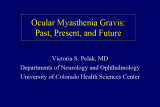 |
Ocular Myasthenia Gravis: Past, Present, Future | Victoria S. Pelak, MD | Slideshow describing condition. | Bilateral Myasthenia Gravis; Bilateral Ptosis; Bilateral Weakness of Adduction; Decompensated Phoria; External Ophthalmoplegia; Familial Myasthenia Gravis; Myasthenic Lid Twitch; Ocular Myasthenia Gravis; Positive Tensilon Test; Pseudo-internuclear Ophthalmoplegia; Tensilon Test; Unilateral Myasthen... |
| 316 |
 |
Cavernous Sinus Meningioma | Shirley H. Wray, MD, PhD, FRCP | Slideshow describing condition. | Abducting Nystagmus; Cavernous Angioma; Convergence Normal; Facial Palsy; Facial Weakness; Fisher's One-and-a-Half Syndrome; Pendular Vertical Oscillations; Pontine Hemorrhage; Unilateral Gaze Palsy Hemorrhage; Unilateral Horizontal Gaze Palsy; Unilateral Internuclear Ophthalmoplegia; Upbeat Nystag... |
| 317 |
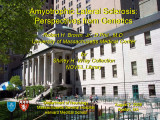 |
Amyotrophic Lateral Sclerosis | Robert H. Brown Jr, D.Phil, MD | Slideshow describing condition. | Bulbar Palsy; CNS Degeneration; Convergence Insufficiency; Familial Amyotrophic Lateral Sclerosis; Lou Gehrig's Disease; Saccadic Breakdown of Horizontal Pursuit; Slow Hypometric Horizontal Saccades; Superoxide Dismutase (SOD1) Gene; Supranuclear Paralysis of Up and Downgaze Degeneration |
| 318 |
 |
Cavernous Angioma | Shirley H. Wray, MD, PhD, FRCP | Slideshow describing condition. | Cavernous Angioma; Convergence Normal; Facial Palsy; Fisher's One-and-a-Half Syndrome; Pendular Vertical Oscillations; Pontine Hemorrhage; Unilateral Gaze Palsy Hemorrhage; Unilateral Horizontal Gaze Palsy; Unilateral Internuclear Ophthalmoplegia; Upbeat Nystagmus on Upgaze |
| 319 |
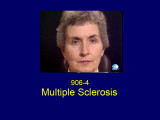 |
Multiple Sclerosis | Shirley H. Wray, MD, PhD, FRCP | Slideshow describing condition. | Bilateral Lid Nystagmus; Horizontal Saccadic Dysmetria; Jerk Oscillations; Lid Nystagmus; Multiple Sclerosis; Primary Position Upbeat Nystagmus; Rotary Nystagmus; Saccadic Dysmetria; Saccadic Pursuit; Square Wave Jerks; Torsional Nystagmus; Upbeat Nystagmus |
| 320 |
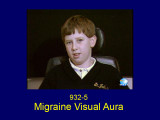 |
Migraine Visual Aura | Shirley H. Wray, MD, PhD, FRCP | Slideshow describing condition. | Alice in Wonderland Syndrome; Macropsia - Hemi-macropsia; Metamorphopsia; Migraine Visual Aura Without Headache; Occipital Lobe; Visual Phenomena |
| 321 |
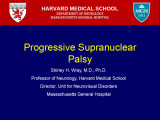 |
Progressive Supranuclear Palsy | Shirley H. Wray, MD, PhD, FRCP | Slideshow describing condition. | Acquired Ocular Motor Apraxia; Apraxia of Eyelid Opening; CNS - Degeneration Convergence absent; Convergence Insufficiency; Global Supranuclear Vertical Gaze Palsy; Impaired Initiation of Horizontal Saccades; Lid Retraction; Positive Glabella Tap; Progressive Supranuclear Palsy - Tauopthay; Progres... |
| 322 |
 |
Supranuclear Paralysis of Downgaze | Shirley H. Wray, MD, PhD, FRCP | Slideshow describing condition. | Absent Convergence; Artery of Percheron; Midbrain Infarct; Ocular Tilt Reaction; Skew Deviation; Somnolence; Supranuclear Paralysis of Downgaze Infarct; Supranuclear Paralysis of Downgaze; Vertical Oculocephalic Reflex Normal |
| 323 |
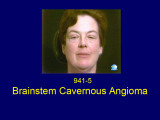 |
Brainstem Cavernous Angioma | Shirley H. Wray, MD, PhD, FRCP | Slideshow describing condition. | Bilateral Horizontal Gaze Palsy Hemorrhage; Bilateral Lid Nystagmus; Cavernous Angioma; Hiccup; Horizontal Gaze Evoked Nystagmus; Lid Nystagmus; Medulla Hemorrhage; Medullary Hemorrhage; Primary Position Upbeat Nystagmus; Upbeat Nystagmus |
| 324 |
 |
Pontine Infarction | Shirley H. Wray, MD, PhD, FRCP | Slideshow describing condition. | Abducting Nystagmus; Convergence Normal; Fisher's One-and-a-Half Syndrome; Pontine Infarct; Unilateral Horizontal Gaze Palsy Infarct; Unilateral Horizontal Gaze Palsy; Unilateral Internuclear Ophthalmoplegia; Upbeat Nystagmus on Upgaze |
| 325 |
 |
Childhood Migraine | Shirley H. Wray, MD, PhD, FRCP | Slideshow describing condition. | Alice in Wonderland Syndrome; Macropsia - Hemi-macropsia; Metamorphopsia; Migraine Visual Aura without Headache; Occipital Lobe; Visual Phenomena |
